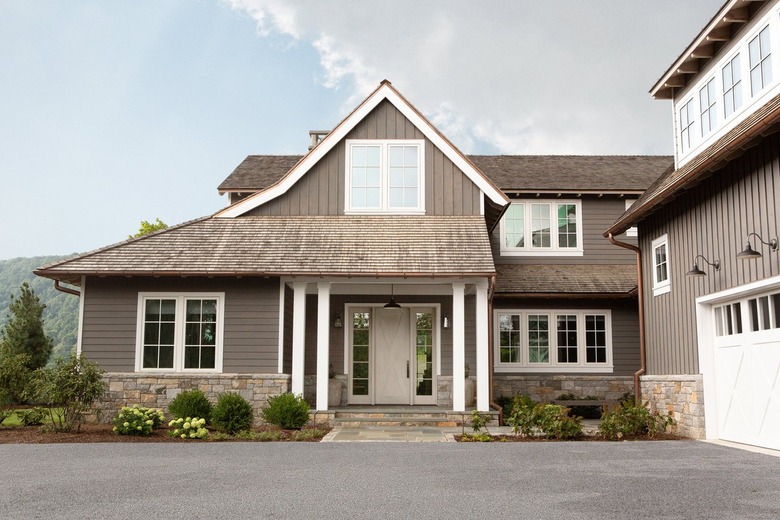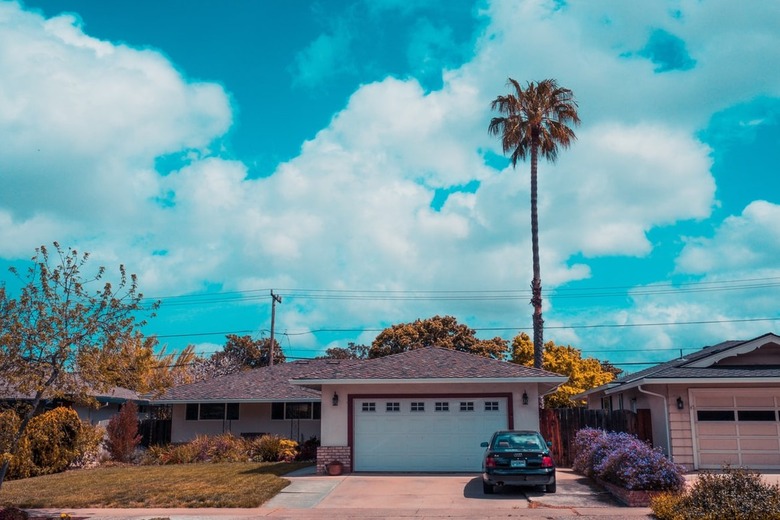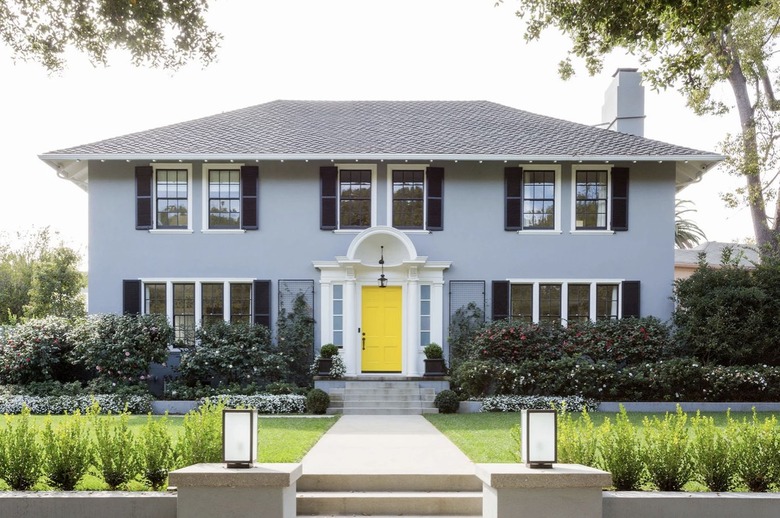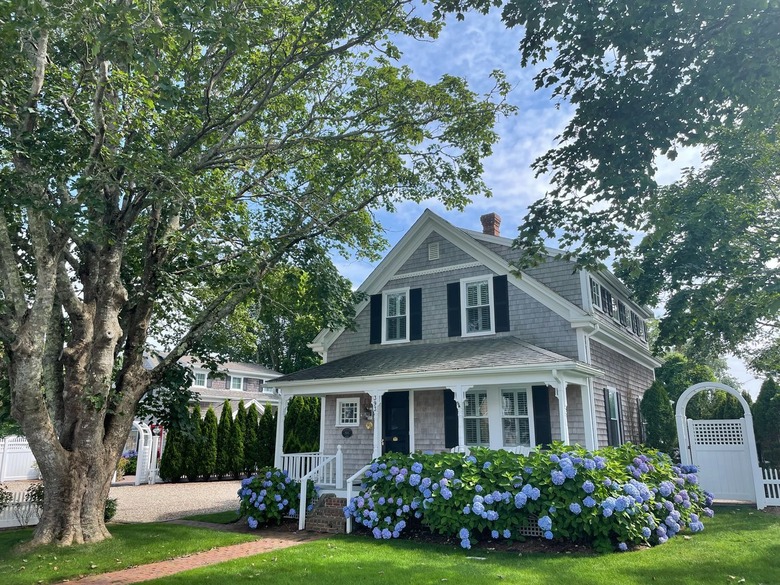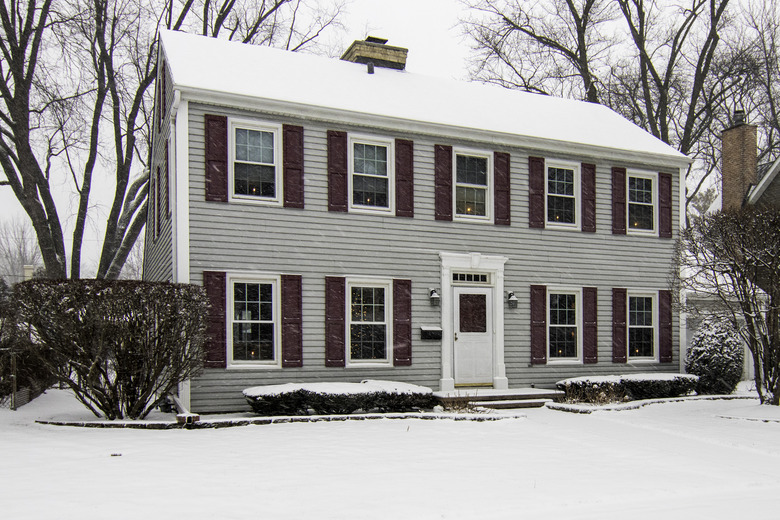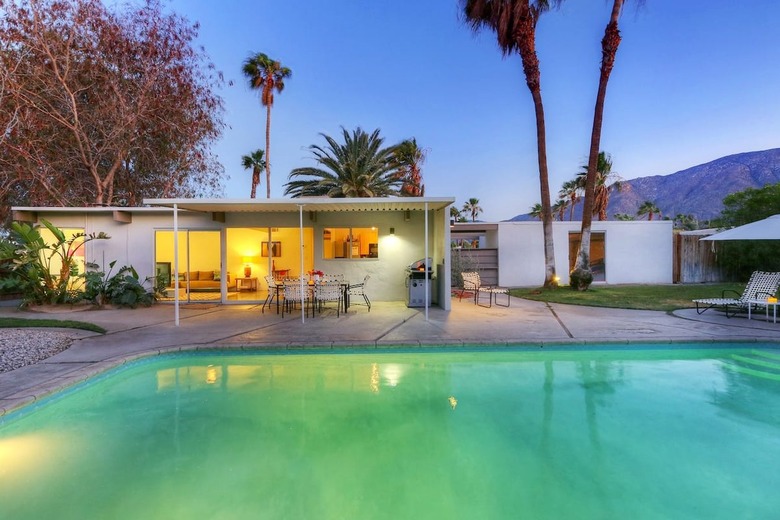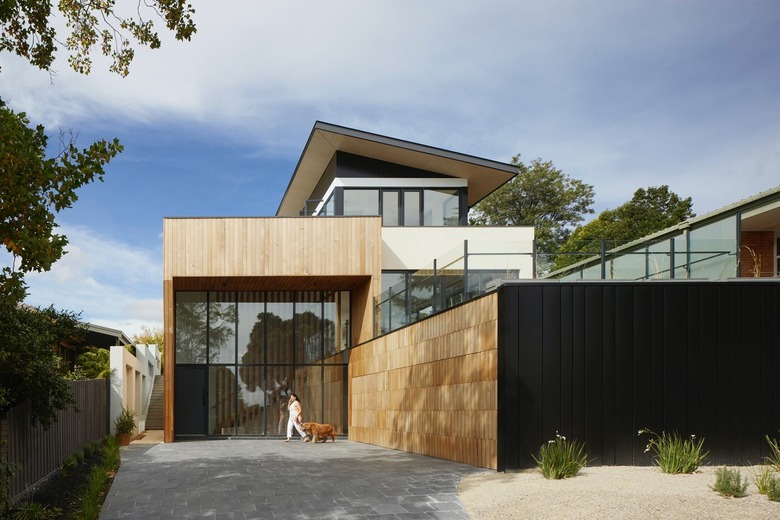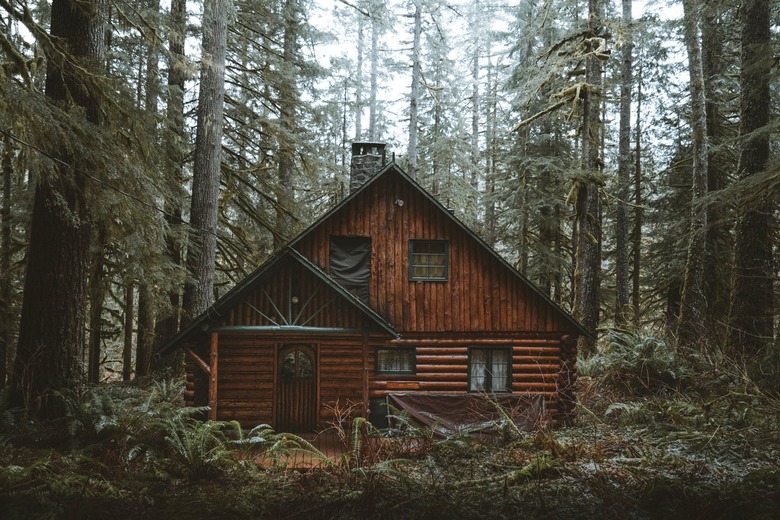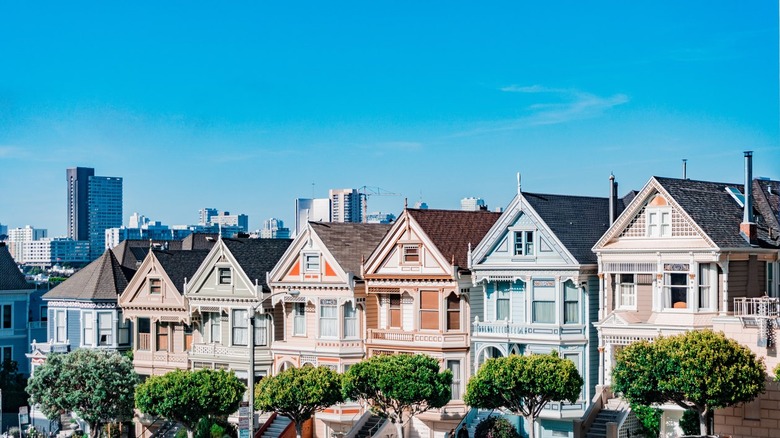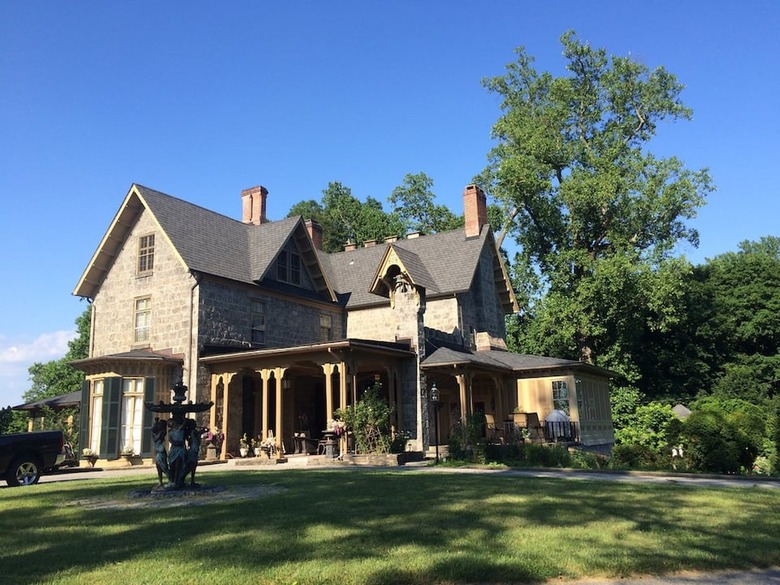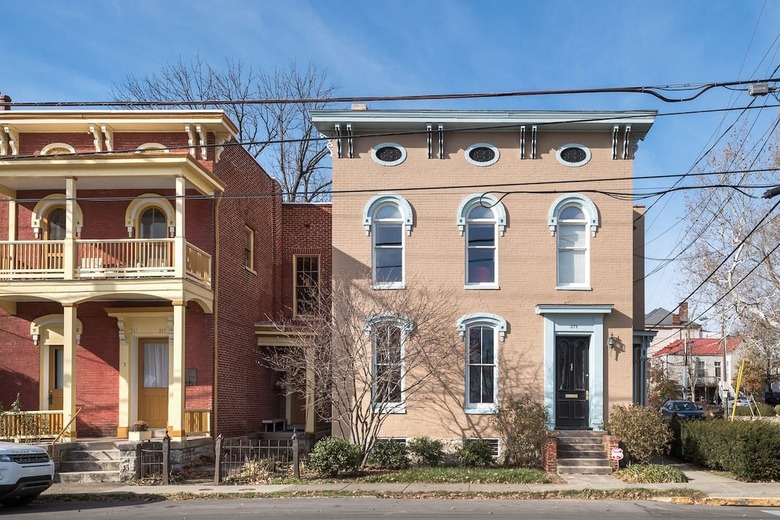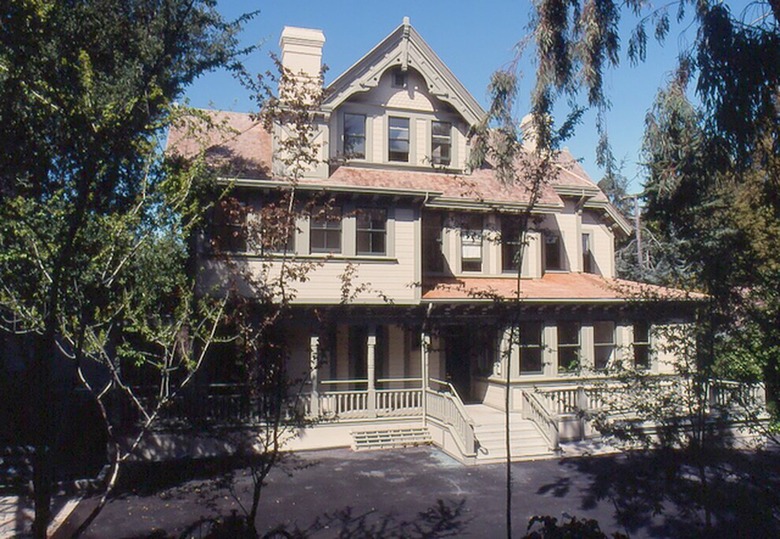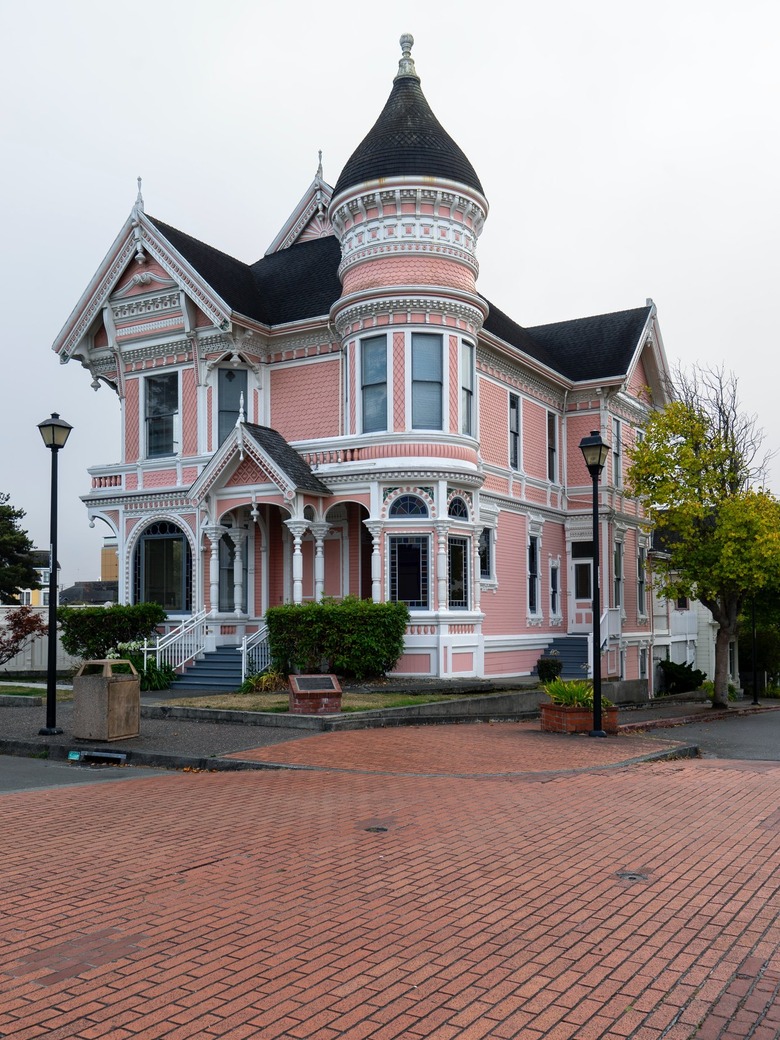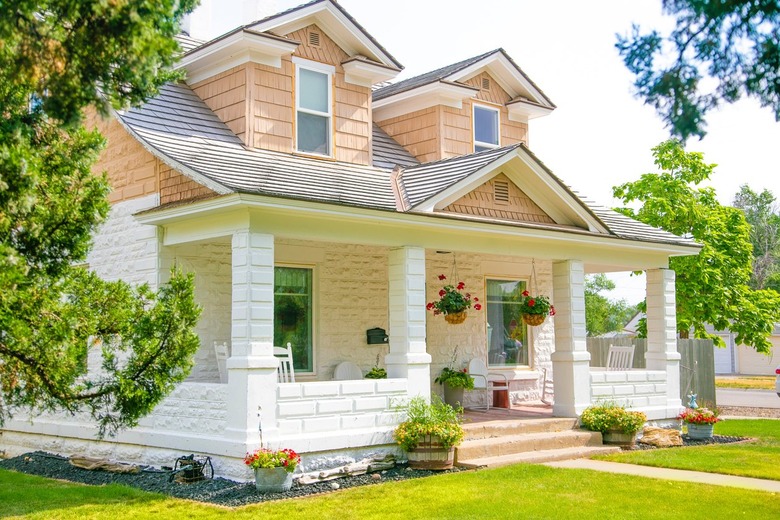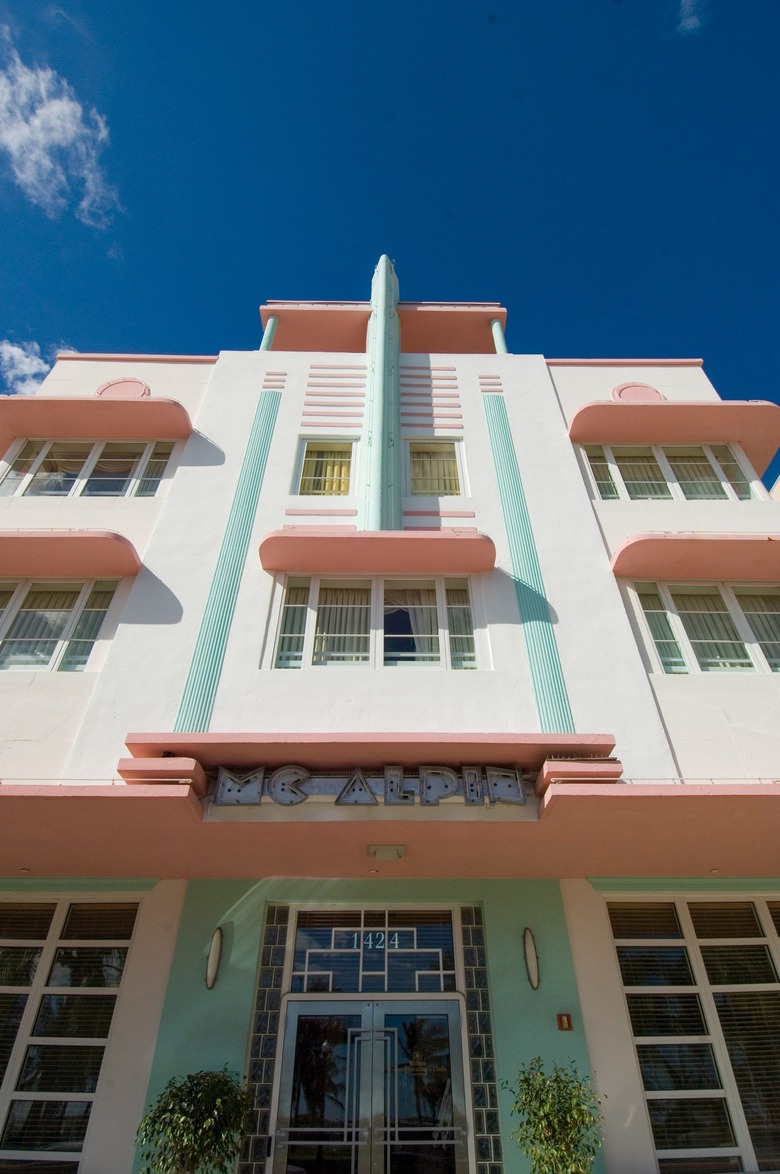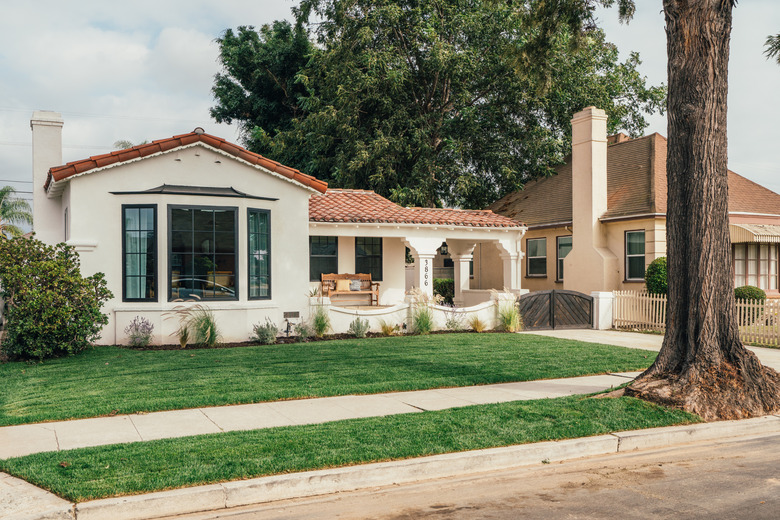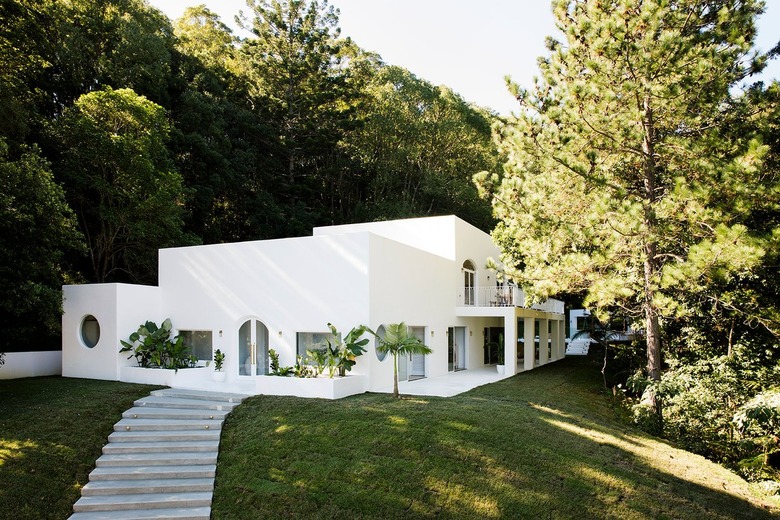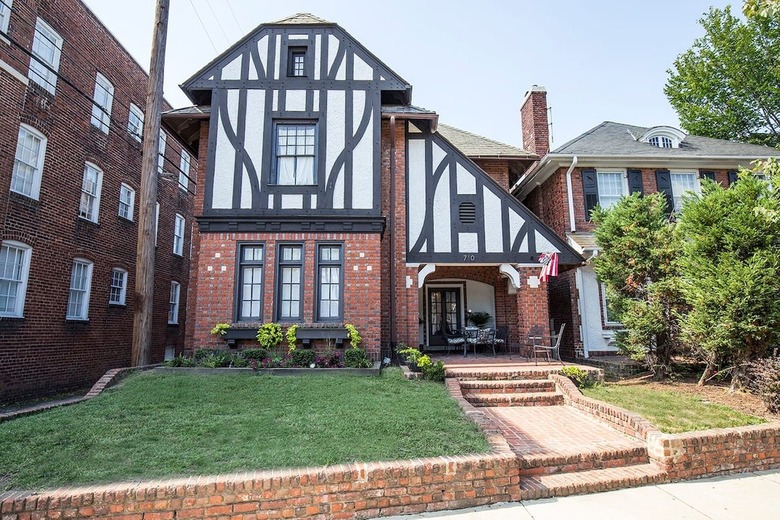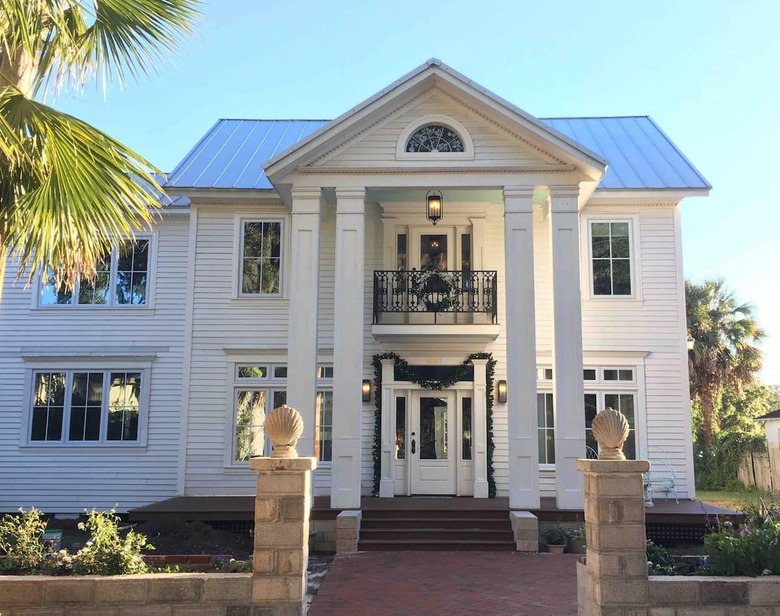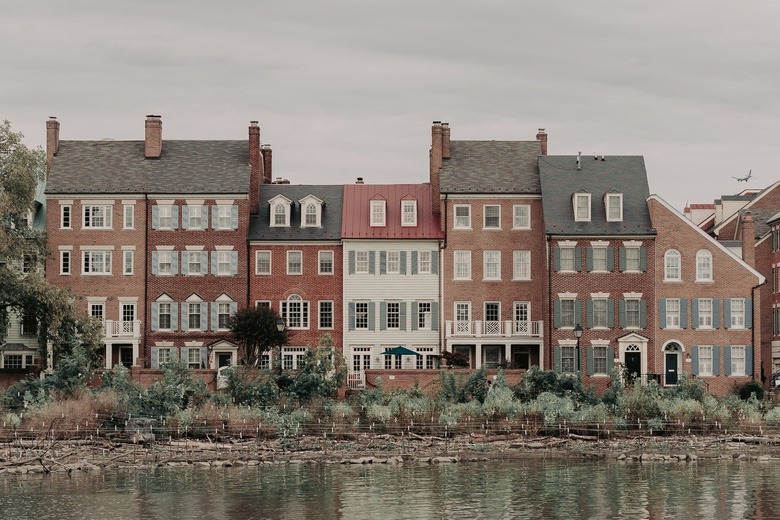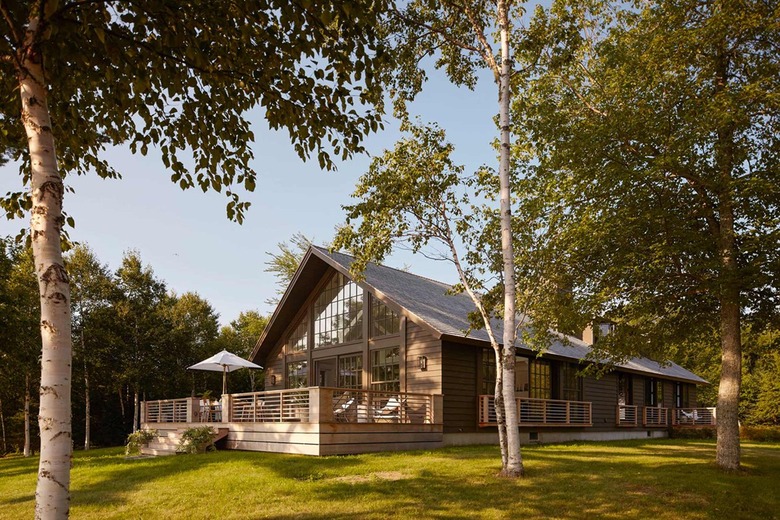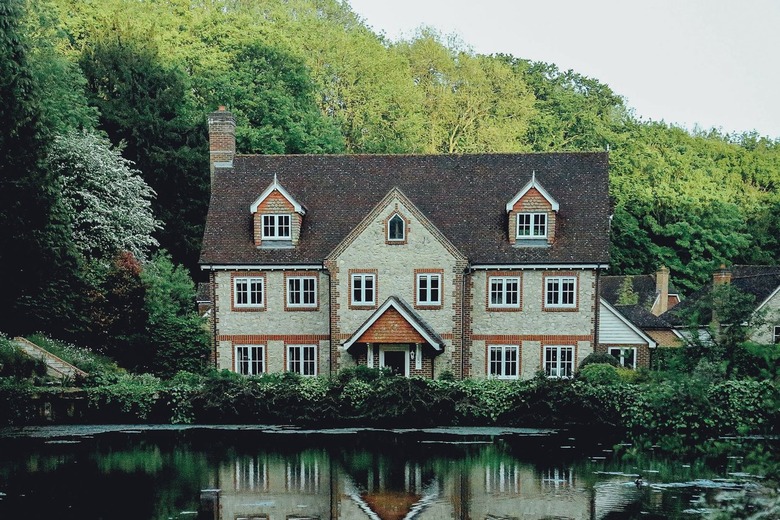Types Of Houses: 24 Most Popular Styles Across The U.S.
Depending on where you live, the types of houses you're accustomed to seeing every day will be different. Maybe you're in Southern California, surrounded by the white stucco and red tile of Spanish colonial and Mediterranean architecture. Maybe you live in a suburb full of craftsman bungalows or modern farmhouses, or in a city lined with row houses.
No matter what your normal is, it's fun to take a step back and admire the breadth of housing styles in the United States, and to learn a little about each of their origins. Did you know that Victorian is an umbrella term with many subcategories, including gothic revival and Italianate? Or that the word bungalow originated from Hindi? Read on for a look at 24 of the most common types of houses in the country.
1. Farmhouse
1. Farmhouse
Farmhouse-style houses have skyrocketed in popularity over the past decade, thanks in large part to Chip and Joanna Gaines of Fixer Upper. However, the origins of the farmhouse go all the way back to 16th-century Europe. Designed for functionality and simplicity, they were made with locally available materials like wood and stone, in a rectangular shape with a simple floor plan, a steep roof, and little decor. Farmers often expanded their homes over time as their families grew, leading to creative, sometimes haphazard, layouts. Nowadays, the farmhouse aesthetic is all about simple, cozy elegance. Characteristic features include shiplap walls, apron-front sinks, neutral color palettes, and exposed beam ceilings.
2. Ranch
2. Ranch
Ranch-style homes are low and sprawling. Usually one story high and asymmetrical in shape, they have open floor plans and vaulted ceilings beneath low-pitched roofs. One of the newer architectural styles on this list, the ranch house originated in Southern California in the 1920s, partly inspired by the designs of Frank Lloyd Wright. They quickly spread across the country in the years after World War II. Designed for warm climates, they generally have large windows — a picture window in front and a sliding glass door in back leading to a patio. They also usually feature an attached garage.
3. Colonial
3. Colonial
Referring to the Colonial period in American history, this term actually encompasses a range of architectural styles, including English, French, Georgian, and Dutch colonial. Together, they established traditional American design with steep gabled roofs, shuttered windows, and bilateral symmetry. Colonial houses today, whether stone or wood, are generally neutral in color, though people sometimes paint their front door a bright color for a modern look. Older colonial homes are usually found on the East Coast, but colonial revival homes have become common across the U.S.
4. Cape Cod
4. Cape Cod
Cape Cod is a type of colonial-style house developed in 17th-century Massachusetts. Their common traits include dormer windows and a centered chimney. Traditionally, they come in four sizes, distinguished by their number of windows: the full Cape with two windows on each side of the door; the half-Cape with one per side; the asymmetrical three-quarter Cape; and a rare quarter-Cape with a single window. Newer Cape Cod-style houses can break from these traditions but usually keep the wide roof and stormy color palette.
5. Saltbox
5. Saltbox
Another example of colonial style, the saltbox has a steep, dramatically asymmetrical roof designed to encourage snow to melt quickly during cold New England winters. Popularized in the 17th and 18th centuries, they got their name from hinged wooden boxes used to store salt, which had a similar shape. These old-fashioned houses can still be found throughout New England and the East Coast today, along with some more modern interpretations of the style.
6. Midcentury Modern
6. Midcentury Modern
Despite being called "modern," midcentury modern style isn't new — but it was when it rose to popularity in the decades after World War II. The term refers not to one specific look but a whole design movement. Thus, midcentury modern houses come in all kinds of shapes — ranch, bungalow, A-frame, and more. Defining characteristics include clean lines and angles, large windows, nature- and sculpture-inspired forms, and outdoor living spaces, like courtyards and patios. While midcentury modern houses can now be found all over the United States, they're still most popular in California.
7. Modern
7. Modern
Like with midcentury modern, modern architecture is not new in the 21st century. The term refers to styles that were innovative when they were built, from around the end of the 19th century through the mid-1980s. Modern homes tend to be sleek and minimal, prioritizing functionality over ornamentation, in contrast to the more ornate styles that came before, like the Victorian. They are often low-profile with open floor plans, and incorporate materials like glass, steel, and reinforced concrete.
8. Contemporary
8. Contemporary
The main difference between modern and contemporary is time. Contemporary style is newer and more diverse, comprising not just one single aesthetic but all kinds of inventive, of-the-moment designs from the '80s through today. Although the term is fluid, houses labeled contemporary are often symmetrical and clean-lined, with minimalist decor inside. They tend to be built with a focus on sustainability and honoring nature, while also having a flair for the dramatic.
9. Cabin
9. Cabin
Cabins are one of the easiest house styles to identify, thanks to their log construction and rustic nature. Though modern cabins can take many different forms, the typical cabin is small and simply built. Their interior layouts are also usually modest, featuring a main room that serves as the focal point. As you might expect, they are often found in nature — in the woods, far outside of cities, where people can get away from it all.
10. Victorian
10. Victorian
Victorian houses originally became popular during Queen Victoria's reign, from 1837 to 1901, which is how the style got its name. You can recognize these houses by their colorful exteriors, complex structures, and intricate woodwork. Their interiors are typically just as intricate, organized not with central hallways but with adjoining rooms — so a bedroom might lead through a bathroom into a sitting room. Victorian style is a blanket term with several subcategories — and many homes incorporate a mix of them in what is called eclectic or folk Victorian.
11. Gothic Revival
11. Gothic Revival
The earliest of the Victorian styles, Gothic revival brought the Middle Ages back to life in the 1800s. These homes, with their steeply gabled roofs and pointed-arch windows, resemble medieval cathedrals. They feature many decorative elements like parapets, spires, carved vergeboards hanging down from the gables, and wraparound porches, often balanced by earthy color palettes. Gothic revival houses are most common in New England.
12. Italianate
12. Italianate
Inspired by Italian Renaissance architecture, Italianate houses look a little different from other Victorians because of their signature flat roofs and rectangular shape. Still, they share other common Victorian traits, like ornate trimmings and colorful facades. Other markers of Italianate style include a square tower in the center of the roof and narrow windows with curved tops. You can find these houses all over the country, especially in cities, where their boxy shape and simple design makes them ideal row houses.
13. Eastlake
13. Eastlake
Another example of Victorian architecture, Eastlake houses were inspired by the carved wood furniture of British designer Charles Locke Eastlake. American Eastlake houses feature mass-produced wood ornamentation, including jigsaw-carved latticework and lathe-turned beaded spindles. One of the most famous examples of the style is the house from the original Charmed, which is still standing in Los Angeles' Echo Park neighborhood.
14. Queen Anne
14. Queen Anne
The last of the Victorian styles on this list, Queen Anne is all about excess. These houses pack on the decorative features: columns, rounded towers, oriel and bay windows, patterned shingles, spindlework, pedimented porches, and more. Queen Anne Victorians were most popular in the United States in the late 1800s and early 1900s, and you can find them all across the country. The official Vice President's residence in Washington, D.C., is a Queen Anne-style house.
15. Craftsman
15. Craftsman
One of the most popular home styles today, craftsman houses came out of the Arts and Crafts Movement of the late 19th and early 20th centuries, which prioritized simplicity, hand-crafting, and harmony with nature. In these homes, natural materials — including wood, stone, and brick — are on display in the form of exposed ceiling beams, large fireplaces, thick crown moldings, wainscoting, and cased openings between rooms. Although craftsman-style houses are more modest in size and style than Victorians, they originally shared the interconnected-room model of floor plan with only minimal hallways separating bedrooms from common areas.
16. Bungalow
16. Bungalow
A bungalow is a small house, usually one or one-and-a-half stories, with a large porch and a low-pitched roof with overhanging eaves. Their name originates from the Hindi word bangla, meaning "Bengali," and they came to the U.S. via the British colonization of India. Today, bungalows appear in many different styles and constructions, including craftsman, Tudor, raised (with a partially above-ground basement), airplane (due to a cockpit-like windowed room on the second floor), and versions named for various regions of the country (California, Chicago, Michigan, Milwaukee, and more). Because of their small size, well-designed bungalows use space wisely with features like built-in shelves for maximum storage.
17. Art Deco
17. Art Deco
A product of the roaring '20s, art deco celebrated luxury and technological advancements, taking inspiration from Egyptian, Native American, and Mesoamerican designs. Art deco architecture is associated with large-scale commercial and public buildings like the Chrysler Building in New York City and the Griffith Park Observatory in Los Angeles, but you can also find its influence on houses and apartment buildings. Defining features include metallic accents, brightly colored terra cotta, stepped profiles inspired by ziggurats, and intricate relief carvings. The style had a revival in the 1980s, and you can find examples of it in cities including Los Angeles and Miami.
18. Spanish Colonial
18. Spanish Colonial
This style dates back to the 16th century, when colonists from Spain built the first Catholic missions in the present-day United States. These missions eventually stretched across the southern part of the country from California to Florida, where you can still see their influence in the ubiquitous white stucco houses with terra cotta roof tiles. Traditional Spanish colonial houses have small windows sometimes covered with iron grilles, exposed wooden support beams, and a central courtyard. You may also see newer interpretations of this style called mission revival, or California mission revival.
19. Mediterranean
19. Mediterranean
Mediterranean and Spanish colonial styles have so much overlap, the two terms are sometimes used interchangeably. Both commonly feature white stucco walls and red roof tiles, and both are popular in California and the Southwest. Mediterranean style is a broader category, inspired not just by Spanish colonial missions but also by architecture from across the whole Mediterranean region, including France, Italy, Greece, and Morocco. Made for warm climates, Mediterranean houses typically include large windows, balconies, and outdoor spaces like courtyards or patios. They also often feature mosaic and wrought iron accents.
20. Tudor
20. Tudor
The term Tudor as we use it in the U.S. is actually a bit of a misnomer. Although the look gets its name from the architecture of the Tudor era of 16th-century England, it's really more of a mix of medieval styles, emphasizing the rustic features of the era over the more stately ones. The most distinctive feature of American Tudor homes is half-timbering, or the visible wooden beams on the exterior walls. In medieval England, these beams were the actual frame of the house, which was built first, then filled in with a clay composite called daub. Nowadays, the beams are usually ornamental. Other common features of Tudor houses include asymmetry, steeply gabled roofs, a second floor that juts out over the first, and mullioned windows.
21. Neoclassical
21. Neoclassical
If a house looks like it could be a government building in Washington, D.C., it's probably neoclassical. This style, popular during the late 18th and early 19th centuries, was inspired by ancient Greece and Rome. It favors symmetry and large-scale geometrical features — like columns, pediments, and domed roofs — over ornamental details. The White House and the Capitol Building are both neoclassical buildings. One of the most famous residential examples is Monticello, the former estate of Thomas Jefferson.
22. Row House
22. Row House
Row houses, also known as townhouses and terraced houses, are attached or very closely spaced houses. Each one may either be occupied by a single family or divided into separate apartment units. They can be found across the country in both cities and suburbs, in many different styles — like the brownstones in New York and Boston, or the Victorians of San Francisco. All the houses in a row may be identical, or they may each look distinct, with different colors, features, and even heights. They may or may not share a roof. Because these houses are attached or nearly so, side windows are either nonexistent or facing a wall, which means residents have to get creative with their interior lighting.
23. Cottage
23. Cottage
Cottages can come in any style or material, so they're defined mostly by their size and context. Even when found in cities, they are small and warm, invoking a modest vacation house in the countryside. They are usually single-story, with cozy features like vaulted ceilings, porches, bay windows, and patios. Some cottages lean into medieval whimsy, with storybook styling like half-timbering; shingled, swayback roofs; or round doors that look fit for hobbits.
24. French Country
24. French Country
Also known as French Provincial or Provencal, French country style is inspired by houses in the countryside of Provence. These houses combine natural materials — like stone, brick, and reclaimed wood — and soft, neutral color palettes with elegant design. Traditionally symmetrical, they feature steep, hipped roofs with clay barrel tiles and two chimneys, one on each end. The windows may be accented with shutters or (delightfully named) eyebrow arches. French country houses are popular in southern states including Texas and the Carolinas.

